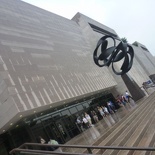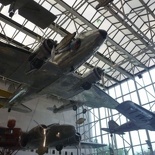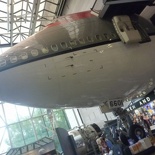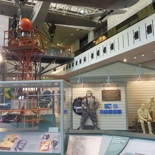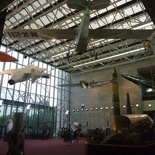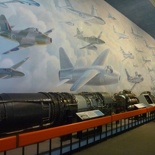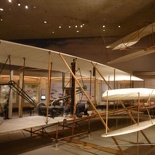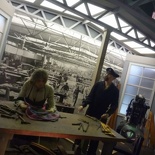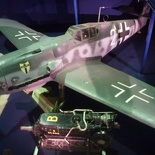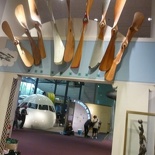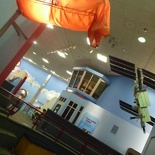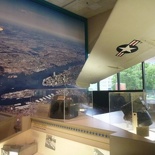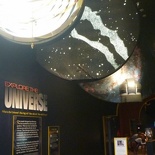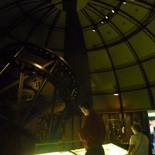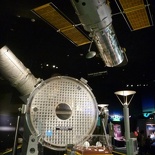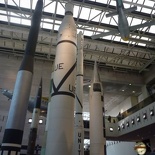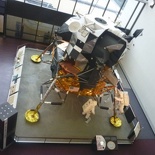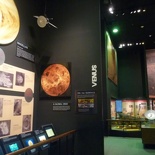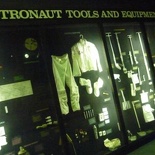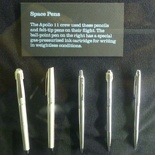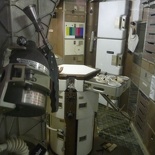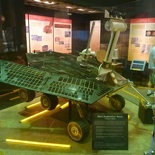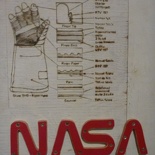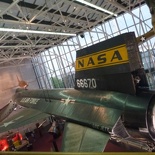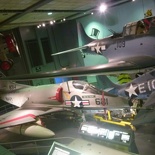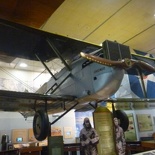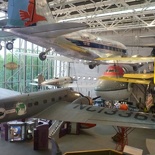The National Air and Space Museum (abbreviated NASM) is one of the museums operated by the Smithsonian Institution located just off the National Mall in Washington, D.C. The museum is home to the largest collection of historic aircraft and spacecraft in the world and was established in 1976 as a center for research into the history and science of aviation, spaceflight, as well as planetary science and terrestrial geology and geophysics. It attracts over 6 million visitor annually.
The building itself was designed by St. Louis-based architect Gyo Obata of Hellmuth and was originally called the National Air Museum when it was formed on August 12, 1946 by an act of Congress, and signed into law by President Harry S. Truman. The museum spots a rather open layout on plan, with many open atriums allowing space for many large aviation exhibits to be showcased, such as the sagittal cutaway view of a former Northwest Boeing 747-100B as well as several full sized commercial planes to be suspended from the ceilings. These open areas are designed by the architects as four simple marble-encased cubes containing the smaller and more theme specific theatrical exhibits lined along the lower and upper floors of the museum too.
Some pieces in the National Air and Space Museum collection date back to the 1876 Centennial Exposition in Philadelphia after which the Chinese Imperial Commission donated a group of kites to the Smithsonian institution, after Smithsonian Secretary Spencer Fullerton Baird convinced exhibitors to leave them here for display given that shipping them home would be far too costly.
The Air and Space Museum itself is the second-most popular of the Smithsonian museums here in Washington D.C. You will be familiar with the museum for it being featured in various blockbuster films such as the setting in the 2009 film Night at the Museum: Battle of the Smithsonian and Transformers: Revenge of the Fallen, where Sam, Mikaela, Wheelie and Agent Simmons woke up Jetfire in SR-71 Blackbird mode. Almost all space and aircraft on display are originals or backups to the originals.
The galleries on the upper floors are home to some permanent displays looking into the invention of flight, namely galleries set and themed to the timeline of the human development into the evolution of flight machines which the museum teaches and recognizes strongly. It starts with nothing more iconic than the actual original wright flyer. With it’s 1st successful milestone on Dec 17, 1903, it is displayed in all it’s glory with several other earlier Wright prototypes and elaborated with various working fixtures displaying how these early simple mechanisms of flight work. It’s interesting to note that all modern planes until today still bare very similar resemblances and traces back to the original wright flyer; employing the same basic principles for flight control of the plane as well as flight lift generation.
The galleries then transition into the modern era of propeller flight, with a rundown of few classic war planes and an early BMW aircraft engine factory. The galleries then go on to embrace the transition to the more efficient use of jets for trust (and starting the whole air speed records race). There are several early jet engines on display, used both in military and commercial aviation.
Take a tour through the Golden ages of flight, looking at the various facets of early air travel complete with various aviation Awards and Insignias ever known to man here on display. Modern aviation will of course won’t reach it’s pinnacle of achievement without the on-going contributions of our women pilots. There are many displays of iconic women pilots in history and awarded service medals recognizing the part our ladies have in place in the skies.
The “How things fly” section is the science discovery part of the museum, which is essentially a discovery fun house teaching all about how planes work- all from instruments to avionics through simple experiential displays and techniques. Wonder how air on an aero-foil creates lift? Have a ago at the water tank or wind tunnel try-out display. Wonder how engine gyroscopic effects will hinder a plane’s movement? Have a go at holding a spinning bicycle wheel with demonstrations courtesy of teaching staff members. It’s fun for all kids and adults young at heart.
Overhead surveillance too plays a major role in the development in key areas of modern air and space flight. The flight surveillance sector teaches just that, showing how we map and document the world we see as of today with high altitude aircraft and satellites. The surveillance section here too covers on the various techniques employed by both military for spying and commercial surveillance aircraft used to capture our world maps like those we see on google earth.
The space and universe galleries teaches about the planets of our of solar system as well as introducing the vastness of the milky way and the machines behind their discoveries. Housed in the museum grounds itself are various early telescopes and astronomy devices including a giant ground telescope complete with it’s shrouding dome, allowing us to peek into the universe and history of space. There is no doubt viewing the milky way and beyond from a telescope is the best from space itself, the orbital telescopes here on display also includes the iconic Hubble and all it’s actual spare parts.
The place is no air and space museum without the spacey bits. The space section of the museum is decked out with a time-line of man’s quest and journey through space, complete with various assortment of artifacts and equipment used on previous space exploration missions, particularly those on the Apollo missions. This of course not forgetting the pioneering technologies before the first space flight, such as the birth of the Balloon and Space Ship One, which actually made all these possible. An Apollo Lunar Module resides in the eastern end of the museum ground floor, near the Apollo–Soyuz Test Project Display and indoor rocket garden reside. These ballistic missiles are so long, they have to be dug into the ground for them to be displayed vertically without having their tops going through the ceiling. The rockets in question here are the Soviet SS-20 and the U.S. Pershing II rockets.
The Apollo galleries showcases every single Apollo completed with the various artifacts, equipment and capsules used by the crew themselves, including the notorious space pens which NASA spent wasted millions researching on. Some notable ones include several Apollo 11 mission equipment and the space suit worn by David Scott on Apollo 15. The entrance to this gallery section houses the rear assembly of the world’s biggest rocket every made- the Saturn 5 as well as several civilian applications satellites for GPS or research purposes. The mock up space displays here also allow you to have a peek into life inside a space capsule, a space station and the space shuttle.
With the exception of a million dollar random rocket, an X-15 experimental high altitude stealth jet or Mars lander rover lying here and there, the NASA art showcase here is a temporary exhibit at the point of my visitation. It’s an art gallery tucked in a corner of the museum housing various art depicting the space organization over it’s course of history, fueling more than 50 years of space exploration till today. In a nutshell, it’s mainly a display of modern space related art with various paintings and sculptures depicting the milestones of NASA, particularly that of the various successful space shuttle missions, launches and the various equipment and facilities which help put man into space.
The experiences of astronauts in space are as told in the artwork too, together with sculptures made out of various engineering parts meant for space travel. Print and canvas media art here includes sketches of the inner mechanical workings of NASA buildings and robot such as the VAB and Mars lander respectively, all put into an arty engineering compilation. There’s even a nice schematic of an astronaut space glove.
The last of the galleries here and that for my visit will be a mock aircraft carrier display called deck 78. It houses various United States Navy aircraft all set in the atmosphere of the lower decks of an aircraft carrier, including a mock-up of the carrier’s living quarters and command bridge. The displays here include collections of several domestic and captured aircraft from World War I, as well as few relatively modern ones including the decommissioned VTOL Harrier jet.
Overall, the National mall museum is good for about 3 hours tops which you can visit for an afternoon together with another museum around the block, especially if you intend to cover as many museums here in a day. There are just so many museums here in Washington. Can’t get enough of the Air and Space museum here in the National Mall? The museum also conducts restoration of its collection out of the museum grounds itself at the Paul E. Garber preservation, restoration, and storage facility in Suitland, Maryland. Contributions for the Air and Space museum don’t just stop at the museum. The Institution themselves operates a separate installation of the museum with a gallery at the Dulles International Airport in Washington itself, all to promote the public interest in aviation.
- New York City & Brooklyn (Photos: New York City & Brooklyn)
- New York Hudson River Cruise, Wall street and Rockefeller Center
- American Museum of Natural History (New York) (Photos: AMNH)
- Washington D.C. (Photos: Washington D.C.)
- Newseum, Washington DC (Photos: The Newseum)
- National Gallery of Art, Washington (Photos: National Gallery of Art)
- Arlington National Cemetery, Washington DC (Photos: Arlington National Cemetery)
- Smithsonian Natural History Museum (Photos: NMNH)
- Smithsonian Air and Space Museum (Photos: Air & Space Museum)
- Orlando, Florida & Magic Kingdom at Walt Disney World Resort (Photos: Disney Magic Kingdom)
- Orlando Disneyland Hollywood (MGM) Studios (Photos: Disneyland Hollywood Studios)
- NASA- Kennedy Space Center, Merritt Island, Cape Canaveral (Photos: Kennedy Space Center)
- Islands of Adventure, Orlando Florida (Photos: Islands of Adventure)
- Universal Studios Orlando, Florida (Photos: Universal Studios Orlando)
- Miami Florida, South Beach and Aventura mall (Photos: Miami Florida)
- Pittsburgh, Pennsylvania (Photos: Pittsburgh, Pennsylvania)
- Cedar Point coaster kingdom, Sandusky Ohio (Photos: Cedar Point)

